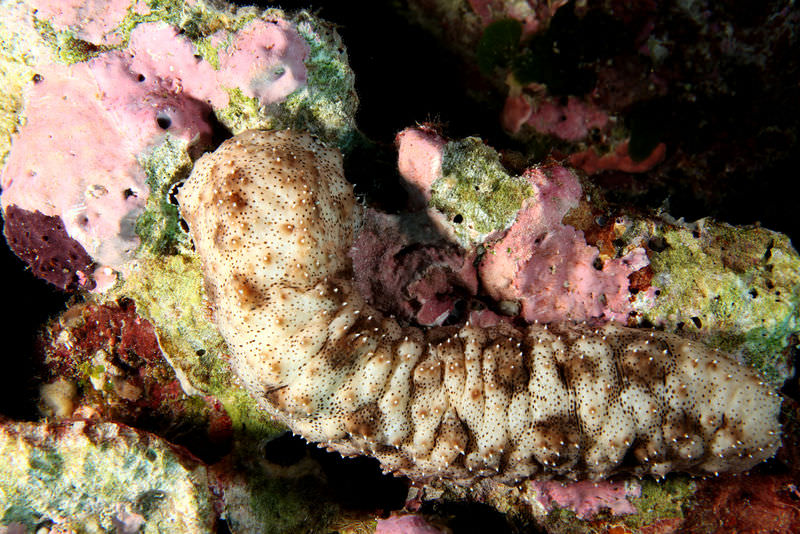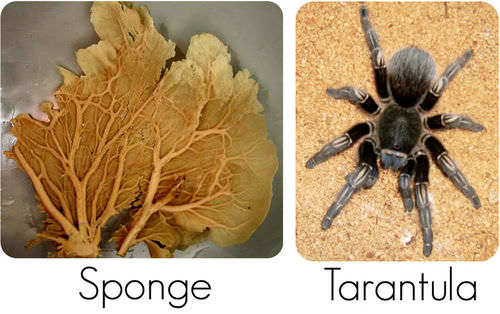11.1 无脊椎生物的多样性
章节大纲
-
What type of animal is a Sea Cucumber?
::海黄瓜是哪种动物?That is a Sea Cucumber, and it is an . The Sea Cucumber is a soft-bodied invertebrate that is related to the starfish and sea urchins. There are over 1,100 that are found worldwide in intertidal zones as well as deep waters.
::这是海参,也是海参。海参是一个软体无脊椎动物,与海星和海胆有关。全世界在潮间带和深海中都发现了1,100多个。Characteristics of Invertebrates
::无脊椎动物的特点The majority of animals today are invertebrates. They have a wide range of physical traits and ways of life. Modern invertebrates include animals as different as the sponge and tarantula. Why are both of these animals classified as invertebrates? What traits do they have common?
::今天,大多数动物都是无脊椎动物,它们具有各种各样的物理特征和生活方式。现代无脊椎动物包括与海绵和不同的动物。为什么这两种动物都被划为无脊椎动物?它们有什么共同特征?Examples of Invertebrates. Both a sponge (left) and tarantula (right) are invertebrates. Can you identify any traits they share?
::无脊椎动物的例子。海绵(左)和(右)都是无脊椎动物。你能辨别出它们共有的特性吗?One trait invertebrates like the sponge and tarantula share is lack of a backbone . In fact, they don’t have any at all. These are defining traits of all invertebrates. Some invertebrates have a skeleton, but it isn’t made of bone. Many other traits of invertebrates show considerable diversity.
::象海绵和山坡共享的无脊椎动物一样,一个特质无脊椎动物是缺乏脊椎的。 事实上,它们根本就没有脊椎动物。 这些是所有无脊椎动物的特征。 有些无脊椎动物有骨骼,但并非由骨头构成的。 其它许多无脊椎动物的特征也表现出相当大的多样性。Digestion
::文摘Invertebrates have one of two types of : an incomplete or complete digestive system . Both are shown in Figure . An incomplete digestive system consists of a digestive cavity with one opening. The single opening serves as both mouth and anus. A complete digestive system consists of a digestive tract with two openings. One opening is the mouth. The other is the anus.
::无脊椎动物有两种类型的一种:不完全或完整的消化系统。两者均在图中显示。不完全的消化系统由一个开口的消化洞组成。单一的开口既是嘴又是肛门。完整的消化系统由两个开口的消化道组成。一个是嘴,另一个是肛门。Two Types of Digestive Systems in Invertebrates. On the left is an incomplete digestive system, found in a jellyfish; on the right is the complete digestive system of a roundworm. Invertebrates may have either of these two types of digestive system. Find the parts of each digestive system in each drawing. How do the two systems differ?
::两种无脊椎动物的消化系统类型。左边是不完整的消化系统,在水母中发现;右边是圆虫的完全消化系统。无脊椎动物可能拥有这两种消化系统中的两种。在每个绘图中查找每个消化系统中的部位。这两个系统有何不同?Movement
::动 动All invertebrates can move on their own during at least some stage of their . However, they may differ in how they move. Several ways are described below.
::所有无脊椎动物至少可以在自己的某一阶段自行迁移,但是在移动方式上可能有所不同,下文将介绍几种方式。-
Some invertebrates are simply carried along by
currents. They cannot control their
movement
in a particular direction. An example is a jellyfish.
::有些无脊椎动物只是由海流随波而行,它们无法控制它们向某一特定方向的移动,例如水母。 -
Other invertebrates can contract
to move independently of water currents or on solid surfaces. They can also control the direction in which they move. An example is a roundworm. It can move forward and to the left or right.
::其他无脊椎动物可以签订合同,不受水流或固体表面的影响移动。他们也可以控制移动的方向。例如,圆虫,可以向前移动,向左或向右移动。 -
Still other invertebrates have specialized
appendages
for movement. For example, they may have jointed legs for walking or climbing or
wings
for flying. An example is an insect such as a fly.
::还有一些无脊椎动物有专门的运动附附物,例如,它们可能用双腿合足行走或爬行,或用翅膀飞翔。例如,苍蝇等昆虫。
Nervous System
::神经系统Most invertebrates have a . The nervous system allows them to sense and respond to their environment. The simplest invertebrate nervous system is just a network of nerves that can sense touch, called a nerve net (see Figure ). Most invertebrates have a more complex nervous system. It may include a brain and several different sense organs .
::大多数无脊椎动物都有神经系统。神经系统允许他们感知和应对环境。最简单的无脊椎神经系统只是一个神经网络,可以感知触觉,称为神经网(见图)。大多数无脊椎动物的神经系统更为复杂,其中可能包括大脑和若干种不同的感官器官。The nervous system of invertebrates.
::无脊椎动物的神经系统Reproduction
::复制复制Most invertebrates reproduce sexually. Diploid adults produce haploid gametes ( and eggs). In some species, the same individuals produce both sperm and eggs . In other species, sperm and eggs are produced by separate male and female individuals. occurs when a sperm and an egg fuse to form a diploid zygote . The zygote develops into an embryo and eventually into a new adult organism . On the way, it may pass through one or more larval stages. A larva (plural, larvae) is a juvenile, or immature, stage of an animal. It is generally quite different in form and function from the adult form of the species. For example, the larva may be able to swim freely, whereas the adult must remain permanently attached to a solid surface.
::多数无脊椎动物在性方面繁殖。在一些物种中,同一批人同时生产精子和卵子。在其他物种中,精子和卵子由不同的男性和女性个体产生。当精子和卵子引信形成状酶时,会发生,zygote会发展成一个胚胎,最终会形成一个新的成年有机体。在途中,它可能经过一个或一个以上的幼虫阶段。幼虫(体、幼虫)是动物的幼年或幼年阶段。在形式和功能上通常与成年物种形式大不相同。例如,幼虫可能能够自由游泳,而成年必须永远与坚固的表面相连。Some invertebrates can also reproduce asexually. This may occur by fission or budding . Fission takes place when an animal simply divides into two parts. Each part then regrows the missing part. The result is two whole organisms. Budding may take place when a parent forms a small bump, or bud. The bud remains attached to the parent while it develops into a new individual.
::某些无脊椎动物也可以进行性繁殖。这可以通过裂变或萌芽发生。当动物仅仅分成两部分时,就会发生裂痕。每一部分然后重新生长缺失的部分。结果为两个完整的有机体。当父母形成小块块或芽时,可能会发生胚胎。芽在发育成一个新的个体时仍与母体相连。Summary
::摘要-
The majority of living animals are invertebrates. Invertebrates lack a backbone.
::大多数活动物是无脊椎动物,无脊椎动物缺乏支柱。 -
Invertebrates may have an incomplete or a complete digestive system.
::无脊椎动物可能有不完整或完整的消化系统。 -
Invertebrates vary in how they move and in the complexity of their nervous system.
::无脊椎动物的移动方式和神经系统的复杂性各不相同。 -
Most invertebrates reproduce sexually. After hatching, many invertebrates pass through one or more larval stages that are different from the adult stage.
::多数无脊椎动物在孵化后会发生性繁殖,许多无脊椎动物在孵化后会经历一个或一个以上与成人阶段不同的幼年阶段。
Review
::回顾-
Describe the range of variation in the nervous systems of invertebrates.
::描述无脊椎动物神经系统的变化范围。 -
Compare and contrast incomplete and complete digestive systems.
::比较和对比不完整和完整的消化系统。 -
Describe fission and budding.
::描述裂变和萌芽。 -
Create a diagram to show the life cycle of an invertebrate with a larval stage. Include simple sketches of the adult and larval stages of the animal.
::创建一个图表, 显示无脊椎动物的生命周期, 包括幼虫阶段。 包括动物成人和幼虫阶段的简单草图 。
-
Some invertebrates are simply carried along by
currents. They cannot control their
movement
in a particular direction. An example is a jellyfish.



